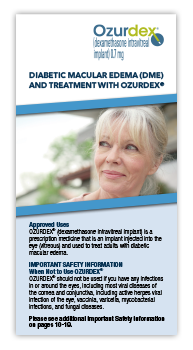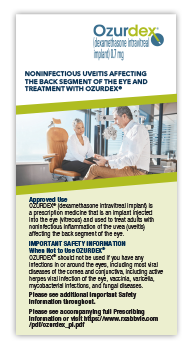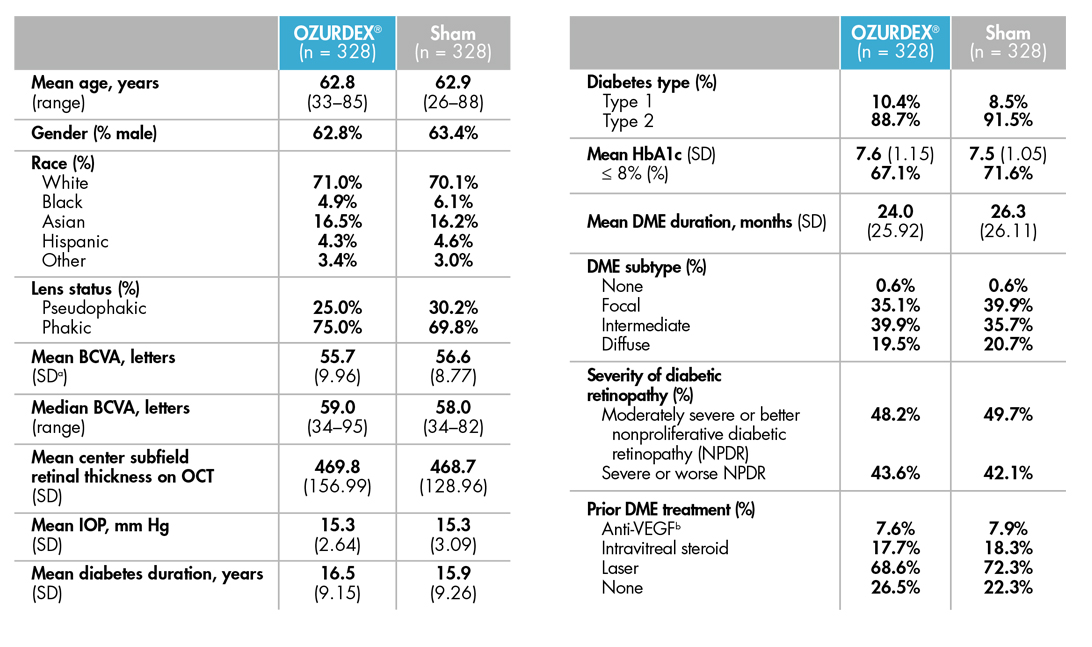CLINICAL EFFICACY
- For diabetic macular edema (DME)
- For macular edema following branch retinal vein occlusion (BRVO)
or central retinal vein occlusion (CRVO) - For noninfectious posterior segment uveitis
- For diabetic macular edema (DME)
- For macular edema following branch retinal vein occlusion (BRVO)
or central retinal vein occlusion (CRVO) - For noninfectious posterior segment uveitis
A PHASE 3, MULTICENTER, MASKED,
RANDOMIZED, SHAM-CONTROLLED,
3-YEAR TRIAL IN DME1,9

- In this phase 3 study, DME patients were randomized to:
— Sham (needleless applicator) (n = 328)
— OZURDEX® (n = 328)
- Specified treatment interval: no more than approximately every 6 months
- Evaluations performed at baseline, every 45 days during year 1, and every 3 months during years 2 and 3
- Escape therapy could be administered at the investigator's discretion at any point during the study
— Patients who received escape therapy were withdrawn from the study
— Efficacy analyses used the last-observation-carried-forward (LOCF) method for these patients
KEY EFFICACY OUTCOME MEASURE9
- Primary endpoint: Percentage of patients gaining ≥ 15 letters (3 lines) in BCVA from baseline
KEY SAFETY MEASURES1,9
- Adverse events
- Intraocular pressure
- Biomicroscopy
- Indirect ophthalmoscopy
- Retroillumination photographs for opacity grading
- Blood pressure and pulse rate
RESULTS IN OVERALL PATIENT POPULATION
OZURDEX® sustained clinically significant vision improvements throughout the 3-year MEAD study1
All Randomized Patients: Visual Acuity Outcomes at Month 391
Measurement
Patients gaining ≥ 15 letters (3 lines) in BVCA (n)
Patients losing ≥ 15 letters in BVCA (n)
Mean change in BVCA (letters) (SDa)
OZURDEX®
(n = 328)
19.5% (64)
13.7% (45)
2.2 (15.88)
Sham
(n = 328)
10.7% (35)
10.7% (35)
0.8 (12.72)
Estimated difference
(95% confidence interval [CI])
8.8% (3.4%, 14.3%)
3.0% (-2.0%, 8.1%)
1.3 (-0.9, 3.4)
Primary Endpoint: Percentage of Patients With ≥ 15-Letter (3-Line) Gains in BCVA From Baseline1
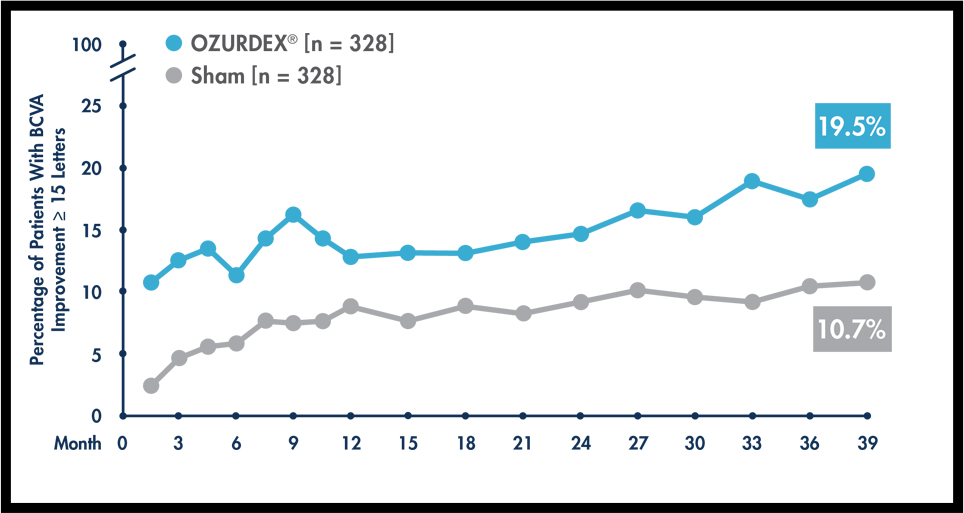
Pooled results of all DME randomized patients with LOCF from 2 multicenter, masked, randomized, sham-controlled studies. The primary endpoint was the proportion of patients with 15 or more letters’ improvement in BCVA from baseline at month 39 or final visit for subjects who exited the study at or prior to month 36. The month 39 extension was included to accommodate the evaluation of safety and efficacy outcomes for subjects who received retreatment at month 36. Only 14% of the study patients completed the month 39 visit (16.8% from OZURDEX® and 12.2% from sham).4,9
EFFICACY IN PSEUDOPHAKIC PATIENTS
OZURDEX® demonstrated BCVA improvement from baseline1,4
Pseudophakic Patients: Visual Acuity Outcomes at Month 391,4
Measurement
Patients gaining ≥ 15 letters (3 lines) in BVCA (n)
Patients losing ≥ 15 letters in BVCA (n)
Mean change in BVCA (letters) (SD)
OZURDEX®
(n = 82)
20% (16)
5% (4)
5.8 (11.6)
Sham
(n = 99)
11% (11)
7% (7)
1.4 (12.3)
Estimated difference
(95% confidence interval [CI])
8.4% (-2.2%, 19.0%)
-2.2% (-9.1%, 4.7%)
4.2 (0.8, 7.6)
Pseudophakic Patients: Mean Change in BCVA From Baseline1

Pooled results from 2 multicenter, masked, randomized, sham-controlled, 3-year studies in patients with DME. Subgroup for pooled data with LOCF. BCVA was measured using a standard Early Treatment Diabetic Retinopathy Study (ETDRS) protocol.4,9
EFFICACY IN PHAKIC PATIENTS
Phakic Patients: Visual Acuity Outcomes at Month 391,4
Measurement
Patients gaining ≥ 15 letters (3 lines) in BVCA (n)
Patients losing ≥ 15 letters in BVCA (n)
Mean change in BVCA (letters) (SD)
OZURDEX®
(n = 246)
20% (48)
17% (41)
1.0 (16.9)
Sham
(n = 229)
11% (24)
12% (28)
0.6 (12.9)
Estimated difference
(95% confidence interval [CI])
9.0% (2.7%, 15.4%)
4.4% (-1.9%, 10.7%)
0.3 (-2.4, 3.0)
Phakic Patients: Mean Change in BCVA From Baseline1
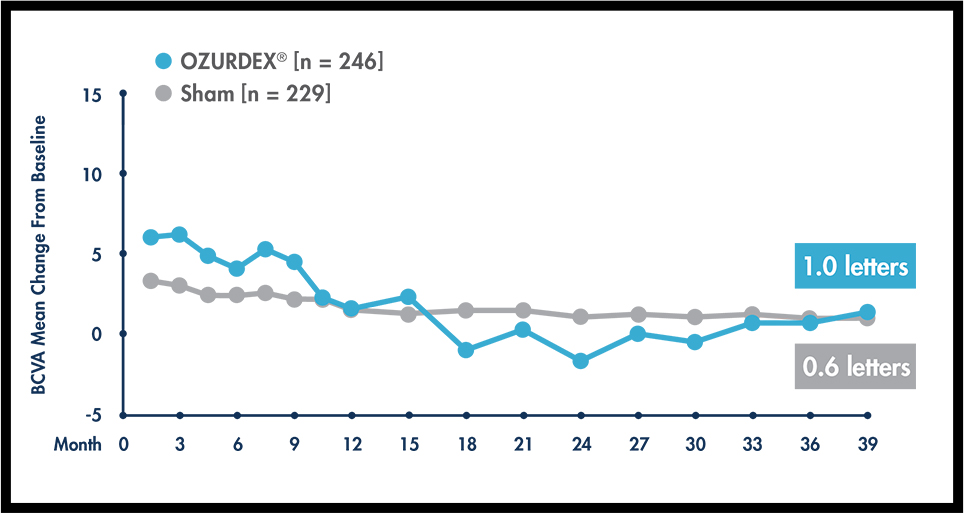
Pooled results of all phakic DME randomized patients with LOCF from 2 multicenter, masked, randomized, sham-controlled studies. The primary endpoint was the proportion of patients with 15 or more letters' improvement in BCVA from baseline at month 39 or final visit for subjects who exited the study at or prior to month 36. The month 39 extension was included to accommodate the evaluation of safety and efficacy outcomes for subjects who received retreatment at month 36. Only 14% of the study patients completed the month 39 visit (16.8% from OZURDEX® and 12.2% from sham).4,9
- 68% of phakic OZURDEX® patients (n = 243) experienced a cataract versus 21% of sham patients (n = 230)4
- The occurrence of cataracts impacted visual acuity during the study4
Patients Who Were Phakic at Baseline: Mean Average Change in BCVA by Change in Lens Status1
Post Hoc Analysis
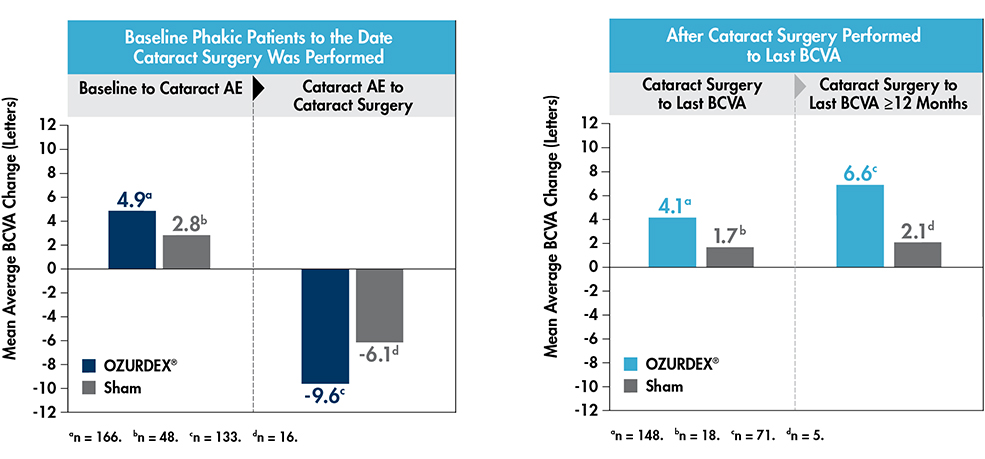
Pooled results from 2 multicenter, masked, randomized, sham-controlled, 3-year trials in patients with DME. Subgroup pooled data with LOCF. BCVA was measured using a standard ETDRS protocol.4,9
